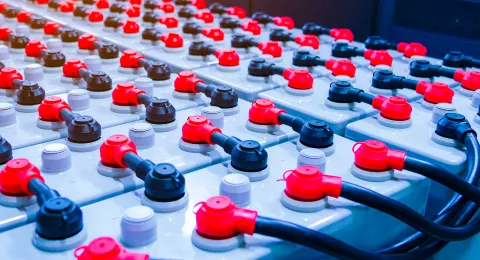Renewable electricity can be produced at a low cost with wind and solar power. However, as availability fluctuates depending on the weather, energy needs to be stored for later use.
Energy can be stored in a variety of forms, such as electrochemical batteries, as potential energy in pumped storage plants, or as heat energy in hot water tanks or other thermal storage systems.
Electricity can easily be released from storage for different purposes, such as daily appliances, electric vehicles, and backup power for industry and the grid.
Hydrogen: solution for long-duration energy storage
The storage duration of energy varies from seconds to up to six months depending on the storage solution.
Electricity produced with solar power is usually stored short-term. For example, a household may use electricity from its solar panels to charge its electric vehicle at night.
Hydrogen – and synthetic fuels made from it – are suitable for longer-term storage. This type of Power-to-X approach is still being developed to increase profitability.
The more an energy storage is charged and discharged, the more profitable it is. At the moment, short-duration energy storages, such as batteries and pumped storage hydropower, are the most cost-efficient.
LUT University provides research-based information on energy
- LUT is a leading university in energy research. Every other year, it publishes a report called the LUT Energy Outlook. The first one was published in 2022 and the second one in 2024.
- The LUT Energy Outlook is based on scientific research and provides reliable information on the state and development trends of the energy system. In addition, the report describes different energy production methods.
- The authors of the report are energy system researchers at LUT University.
- The LUT Energy Outlook is targeted for experts and decision-makers as well as regular citizens.
The Curious People newsletter shares our solutions for helping build resilient communities, industry, and businesses while promoting the energy transition and the regenerative use of natural resources.
Sodium for future batteries
Lithium-ion batteries have rapidly become the most common short-term electricity storage solution. Chemical battery storage is driven especially by the electrification of transportation and the automotive industry’s need for vehicle batteries. However, the availability of raw materials and production-related challenges pose obstacles in the battery market.
To address these issues, sodium-ion batteries have been developed as an alternative that reduces the need for raw materials needed in lithium-ion batteries. Their performance is slightly lower, but sodium is more commonly available and less expensive than lithium.
Energy in the ground, water, and air
Energy can also be stored in systems based on compressed air, air liquefaction, cryophysics, and vanadium redox batteries.
The utilization of those technologies is still quite limited, but related storage methods are becoming more common and keep evolving as the production of renewable energy increases. Sustainability and costs define the development trends of energy storage systems.
More information:









